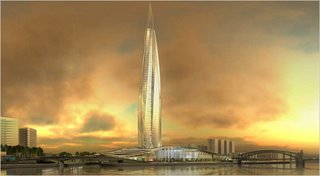
ST. PETERSBURG, Russia, Dec. 1 — Russia’s largest company, Gazprom, announced on Friday that it had chosen the architecture firm RMJM London to design this city’s tallest building, brushing aside arguments from preservationists and residents that the project — whoever the architect — would destroy the city’s architectural harmony.
RMJM’s winning proposal includes a twisting glass tower that would anchor a business and residential center planned for a site on the Neva River opposite the Smolny Cathedral, one of the city’s most famous landmarks.
As now designed, it would rise 1,299 feet — higher even the Peter and Paul Cathedral, built 300 years ago by Peter the Great, which is just over 400 feet tall.
Gazprom’s chief executive, Aleksei B. Miller, hailed the project as a “new symbol of St. Petersburg” akin to city landmarks including the Admiralty, St. Isaac’s Church and the Peter and Paul Cathedral.
“This new, modern project will give birth to a new mentality for St. Petersburg, which lives in a new, modern civilization,” said Mr. Miller, appearing with the city’s governor, Valentina I. Matviyenko. “And its citizens will feel the pulse of the new economy, the pulse of the contemporary world.”
Gazprom selected the RMJM proposal over five other designs by the noted architects Jean Nouvel of Paris; Massimiliano Fuksas of Rome; the Swiss team of Jacques Herzog and Pierre de Meuron; Rem Koolhaas of Rotterdam; and Daniel Libeskind of Berlin.
The competition stirred weeks of ferocious debate. Even as Gazprom’s executives met with city officials and experts on the selection commission at the company’s headquarters on the English Embankment, a small group of protesters passed back and forth aboard a small trawler in the Neva, dressed as clowns and mental patients and holding a sign deriding the project. “Lunatics City,” the sign said. (The project is referred to as Gazprom City.)
There was also dissension within the selection panel. The Japanese architect Kisho Kurokawa, who was invited to serve as a member of the jury, read a two-page statement on Friday describing his vision for St. Petersburg, which would preserve its cityscape on a lower scale, and opposing any of the projects under consideration. He then resigned from the jury and left. In a telephone interview later, he said the city’s current limit on building heights was “the most sensitive issue to keeping the existing cultural value of the old city center.”
Before the architect was chosen, the project came under attack on several fronts, and potential challenges remain.
The St. Petersburg Union of Architects, the director of the State Hermitage Museum and other preservation groups have threatened to challenge it in court. This week three members of the city’s parliament appealed to the country’s prosecutor general, saying the project would violate budget rules and a city zoning ordinance that restricts buildings in that part of the city to 157 feet.
One of the lawmakers, Mikhail I. Amosov, said on Friday that the construction of a skyscraper, as Gazprom specified when it solicited proposals, would intrude into St. Petersburg’s horizontal cityscape, which has remained largely unaltered for two centuries.
“Eventually we are going to lose the shape of St. Petersburg that we inherited from previous generations,” Mr. Amosov said after Gazprom announced the decision.
With offices throughout Britain and in Beijing, Shanghai, Hong Kong, Singapore and Bangkok, RMJM ranks among the world’s top 15 architecture firms in size. The St. Petersburg commission will significantly expand the firm’s presence in Russia, where it is already building a 46-story office tower in Moscow called the City Palace.
RMJM’s managing director in Britain, Tony Kettle, said in a telephone interview that the firm designed the tower with St. Petersburg’s cityscape in mind, evoking the city’s Baroque architecture, especially its punctuating spires.
“We’ve created a new spire that elegantly breaks into the sky,” he said.
Mr. Miller and Ms. Matviyenko said the decision to select RMJM had been unanimous and made no mention of Mr. Kurokawa’s resignation. Planners said that RMJM’s design had also drawn the most votes from visitors to the project’s Web site, www.gazprom-city.info.
They emphasized that while they had chosen a design, the exact details remain undecided. Philip Nikandrov, RMJM’s Moscow director, said the project’s most controversial feature — its height — could still be reconsidered.
Ms. Matviyenko, the St. Petersburg governor and a close ally of President Vladimir V. Putin, the city’s most prominent native, strongly defended the project against its critics. She said the project’s site was outside the historic center, which is recognized by Unesco as a cultural landmark. She added that Gazprom’s willingness to build a business center for its newly acquired oil company would inject sorely needed revenue into the city, which has not enjoyed the energy-fueled boom that has transformed Moscow.
“Without big companies coming, without turning the city into a financial and economic center, we shall never have these resources,” she said, “and the unique architectural heritage in the center of the city will be quietly falling apart before our eyes.”

No comments:
Post a Comment